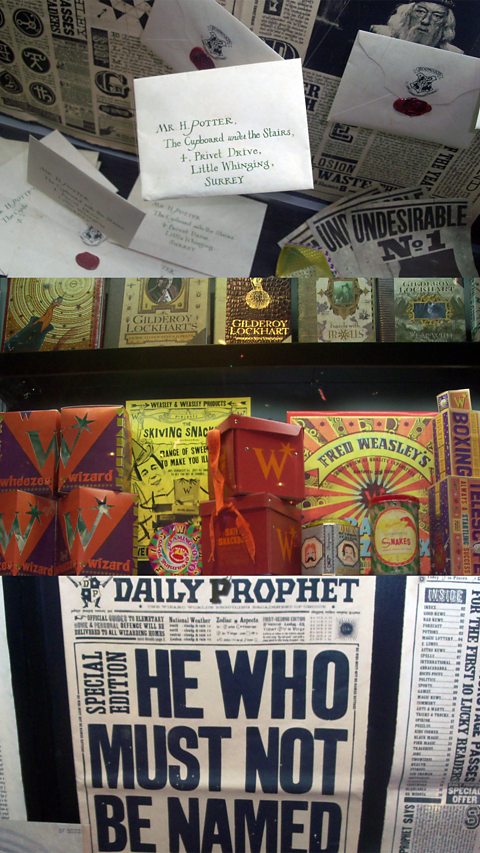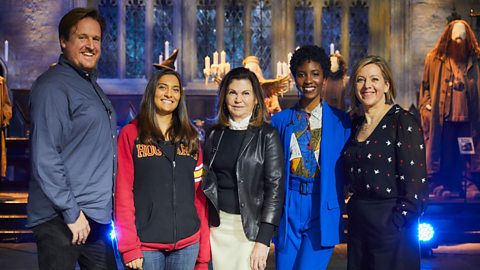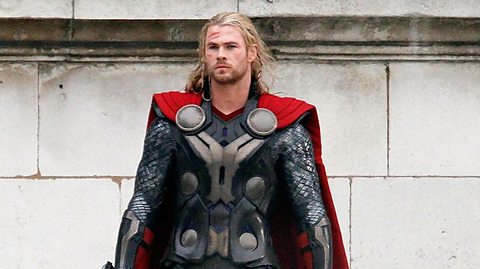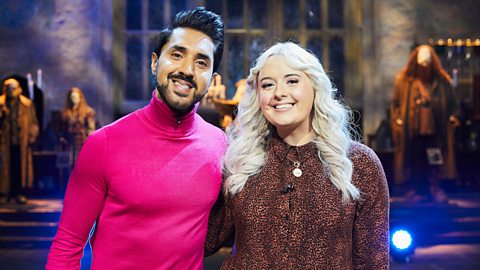Meet Miraphora Mina – graphic designer, Hufflepuff, and part of the design duo behind the graphic props for the Harry Potter and Fantastic Beasts film series. Part of our Making the Magic collection.
I'm Mira Mina and I'm a graphic designer for film.
At school… I was a bit naughty, actually, at school – I was probably a marauder, actually, so had I had The Marauder's Map that would have been ideal, but I think often creativity gets mistaken for naughtiness and probably the two things were happening at the same time and I was always making, drawing, creating and I really knuckled down to work when I had an opportunity to do all those things properly at Art school.
When I was at school, I had no idea that I would even work in film and I was training to do theatre design, so set design. I didn't even know that graphic design for film existed when I started working in film because it didn't as an official role. It was only maybe about 20 years ago that it became a role that was defined and acknowledged by producers and filmmakers, so it's a relatively new role and from having had about six people in the industry is now over 300 so that shows that there actually is a career path now for that role.
I think the most iconic thing that I've been involved in making on Harry Potter was The Marauder's Map and all The Daily Prophet newspapers. But The Marauder's Map was a real sort of adventure in design for us because it was such a brilliant magical tool to push the story forward and that's really what we're having to deal with all the time, but sometimes you get a really great piece that J.K. Rowling has written but, in this case, she only described it as a square piece of folded parchment that the Weasley twins take out. Then it becomes what it does. But we had to really think about who the characters were. It's not my map, it's the four marauders' map and how would they express themselves and be a bit devious and crafty in the way that they created this magical tool that only they had done? So it's thinking about trying to manifest their personalities in the piece and that's what we do every time we're thinking of something, even stuff in here for Dumbledore but, yeah, that was a great adventure.
Ultimately, our role is to try and push the story forward by virtue of the details that are in people’s hands or on walls – all the things are connected by graphic design.
What does your role involve?

As a graphic designer, I work with my business partner, Eduardo Lima, to imagine and create graphic universes for films. Anything that needs to convey a message visually is our remit. So, for the Harry Potter films, that's things like The Daily Prophet newspaper, Harry's Hogwarts acceptance letter or the packaging for Weasley's Wizard Wheezes joke shop products.
Graphic designer wasn't an official role in the film industry when I started out. There were always people designing props with graphic elements but it wasn't really recognised as a distinct role. There used to be about six people doing this kind of work for film in this country and now there are over 300 so I think it became obvious to the industry that that role needed to be defined and acknowledged.
What have you worked on?
We've worked on all the Harry Potter and the Fantastic Beasts films, as well as a number of other Wizarding World commissions including designing all the graphic elements for The Wizarding World of Harry Potter — Diagon Alley at Universal Orlando Resort. Our studio, MinaLima, has also created graphic props for films like Sweeney Todd, The Golden Compass and The Imitation Game. Outside of film, we've illustrated a bestselling book series for HarperCollins and set up a gallery and store to showcase our work.

How did you get your job?
I did an Art foundation course and then a Theatre Design qualification. After that, I studied Film Design at the National Film and Television School (NFTS). On the panel for my NFTS interview was Stuart Craig, who went on to be the production designer for the Harry Potter films. He supported me and became a mentor figure. I left NFTS a year early because I had a job offer through one of my tutors.
I built up my experience of working in the art department, and eventually as graphic prop designer, for films. Then, in 2000, I got a call from Stuart offering me a four-month stint on the Harry Potter films, which turned into years! It's where I met Eduardo, who I went on to set up a design studio with.
What's your career highlight?
Getting the chance to do Harry Potter from day one to now – about 20 years later – has been incredible. When we finished the original eight films, it was only the beginning of another chapter with our studio and projects that continue to challenge us.
Miraphora's recent projects
| Year | Project |
|---|---|
| 2015-present | Fantastic Beasts films |
| 2016 | The Legend of Tarzan |
| 2014 | The Imitation Game |
| 2009 | MinaLima design studio launch |
| 2007 | Sweeney Todd: The Demon Barber of Fleet Street |
| 2007 | The Golden Compass |
| 2001-2011 | Harry Potter films |
Miraphora's top tips
- A passion for detail is essential – if you're going for an interview, don't be afraid to show that enthusiasm! For example, you could bring a scrapbook of things that have inspired you to interviews to show the thinking behind your work
- Keep your hand working, not just the computer. It's really important to keep up your skills for hand-produced work
- Be aware that it's not all glitz and glamour. There are lots of of quite mundane processes that are part of the job – not every day is a Marauder's Map day!

Want to know more?
- The Graphics Union is the union for graphic designers for Film and TV in the UK. Mina recommends this as a good place to offer up your services for work or placements
- You can also find out more on the National Careers Service website about how to become a graphic designer
- Check out Warner Bros. Creative Talent for scholarships, apprenticeships, work and training placements, mentoring and masterclass opportunities.

Making the Magic: Inside jobs in film. collection
Are you spellbound by the Wizarding World films? Meet the people who work in the film industry and make the magic happen.

Four jobs you didn't know existed in filmmaking
Now you think about it, someone had to have invented Klingon for Star Trek, right?

Making The Magic: From Story To Screen. video
BBC Teach is partnering with the Wizarding World to offer students in the UK an introduction to the myriad of roles and careers available on a film production in an exciting interactive lesson on Wednesday, March 4th, 2020.
